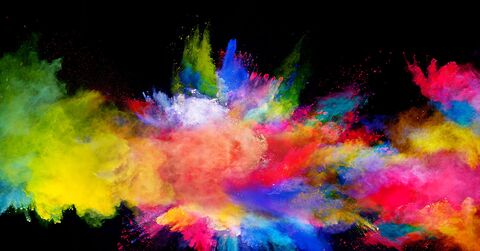Colour theory in marketing
Unless you’ve been on a digital detox for the past year or so, you have probably heard the term ‘Millennial Pink’. The colour is everywhere. From designer clothes to magazine covers, you’ve probably already seen the Grand Budapest Hotel-esque shade over 40 times today. After receiving the coveted title of ‘Pantone colour of the year’ in 2016, the colour has taken the millennial (and marketing sphere) by storm. But this is by no means the first time colour has dictated marketing trends.
Colour theory has always played a key role in big decisions made in the advertising and marketing industry. In fact, a recent study revealed that 90% of snap judgements made on products can be based on colour alone. So - other than adding a welcome pop of colour to your tube journey - how do the colours chosen for adverts affect customers’ responses to them? You can think of this as a key to your advertising mood ring.
Millennial Pink (aka Pale Dogwood)

In short, it’s pink with less blue, leaving a beige-y hue that looks incredible with deep green houseplants. If you’ve spent any time at all on Instagram, you already know this. Millennial Pink is important for advertising because it has done the impossible - sold a shade of pink to a male audience. Of course, the psychology behind being drawn to a colour goes far beyond the preconceptions you’ve been taught about gender-driven colours. This has allowed advertisers to use pink in their advertising without necessarily risking losing a large demographic of their audience. In fact, the ‘androgynous’ colour is a strong representation of youth and their movement away from gender-defined colours.
Monochrome

When there’s so much colour on offer, it might seem unwise to stick to the OG (original gangster) monochrome the first newspaper adverts subscribed to. However, some companies have harnessed the power of simplicity to reach their audiences. In the case of affordable skincare brand The Ordinary, opting for a monochrome colour palette is intricately tied to the product itself. The company’s overarching promise to its customers is to provide clinical-grade products at a fraction of the price, through saving money on packaging. The ‘minimal’ packaging does something unexpected - it makes the budget products look luxury. Using only monochrome packaging means that the various pipette-topped glass bottles line up beautifully on any dresser. In fact, they make you want to throw away all the brash, colourful, immature products and paint your skincare regime in simple black and white. That’s colour theory done right.
Red

We see red every day in various forms (whether emotionally or simply in the realm of advertising). It could be that urgent bill with the crimson band at the top that you can’t stop thinking about. It could also be the ever-so-tempting chip box colour from McDonald’s. Is your stomach rumbling yet? Well, it just well could be. The colour red is associated with hunger and has proved to make people feel hungry. Combine that with the urgency associated with fire engine red and you have a recipe for impulsive buying. Maybe that’s why they call it fast-food.
So now you know how the colours surrounding you every day could affect your purchasing decisions. The important question is: what do you associate our “Bright Sun” shade of yellow with? We can only hope it makes you think of excellently-written blog posts.
We're a creative agency in London and Singapore. We help our clients break through the noise. We'd love to hear from you so do drop us a line
